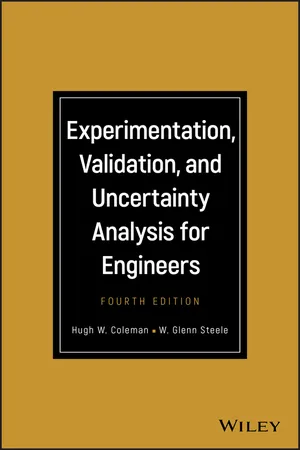
Experimentation, Validation, and Uncertainty Analysis for Engineers
- English
- ePUB (mobile friendly)
- Available on iOS & Android
Experimentation, Validation, and Uncertainty Analysis for Engineers
About This Book
Helps engineers and scientists assess and manage uncertainty at all stages of experimentation and validation of simulations
Fully updated from its previous edition, Experimentation, Validation, and Uncertainty Analysis for Engineers, Fourth Edition includes expanded coverage and new examples of applying the Monte Carlo Method (MCM) in performing uncertainty analyses. Presenting the current, internationally accepted methodology from ISO, ANSI, and ASME standards for propagating uncertainties using both the MCM and the Taylor Series Method (TSM), it provides a logical approach to experimentation and validation through the application of uncertainty analysis in the planning, design, construction, debugging, execution, data analysis, and reporting phases of experimental and validation programs. It also illustrates how to use a spreadsheet approach to apply the MCM and the TSM, based on the authors' experience in applying uncertainty analysis in complex, large-scale testing of real engineering systems.
Experimentation, Validation, and Uncertainty Analysis for Engineers, Fourth Edition includes examples throughout, contains end of chapter problems, and is accompanied by the authors' website www.uncertainty-analysis.com.
- Guides readers through all aspects of experimentation, validation, and uncertainty analysis
- Emphasizes the use of the Monte Carlo Method in performing uncertainty analysis
- Includes complete new examples throughout
- Features workable problems at the end of chapters
Experimentation, Validation, and Uncertainty Analysis for Engineers, Fourth Edition is an ideal text and guide for researchers, engineers, and graduate and senior undergraduate students in engineering and science disciplines. Knowledge of the material in this Fourth Edition is a must for those involved in executing or managing experimental programs or validating models and simulations.
Frequently asked questions
Information
1
EXPERIMENTATION, ERRORS, AND UNCERTAINTY
1-1 EXPERIMENTATION
1-1.1 Why Is Experimentation Necessary?

1-1.2 Degree of Goodness and Uncertainty Analysis
Table of contents
- COVER
- TITLE PAGE
- TABLE OF CONTENTS
- PREFACE
- 1 EXPERIMENTATION, ERRORS, AND UNCERTAINTY
- 2 COVERAGE AND CONFIDENCE INTERVALS FOR AN INDIVIDUAL MEASURED VARIABLE
- 3 UNCERTAINTY IN A RESULT DETERMINED FROM MULTIPLE VARIABLES
- 4 GENERAL UNCERTAINTY ANALYSIS USING THE TAYLOR SERIES METHOD (TSM)
- 5 DETAILED UNCERTAINTY ANALYSIS: OVERVIEW AND DETERMINING RANDOM UNCERTAINTIES IN RESULTS
- 6 DETAILED UNCERTAINTY ANALYSIS: DETERMINING SYSTEMATIC UNCERTAINTIES IN RESULTS
- 7 DETAILED UNCERTAINTY ANALYSIS: COMPREHENSIVE EXAMPLES
- 8 THE UNCERTAINTY ASSOCIATED WITH THE USE OF REGRESSIONS
- 9 VALIDATION OF SIMULATIONS
- ANSWERS TO SELECTED PROBLEMS
- APPENDIX A: USEFUL STATISTICS
- APPENDIX B: TAYLOR SERIES METHOD (TSM) FOR UNCERTAINTY PROPAGATION
- APPENDIX C: COMPARISON OF MODELS FOR CALCULATION OF UNCERTAINTY
- APPENDIX D: SHORTEST COVERAGE INTERVAL FOR MONTE CARLO METHOD
- APPENDIX E: ASYMMETRIC SYSTEMATIC UNCERTAINTIES
- APPENDIX F: DYNAMIC RESPONSE OF INSTRUMENT SYSTEMS
- INDEX
- END USER LICENSE AGREEMENT